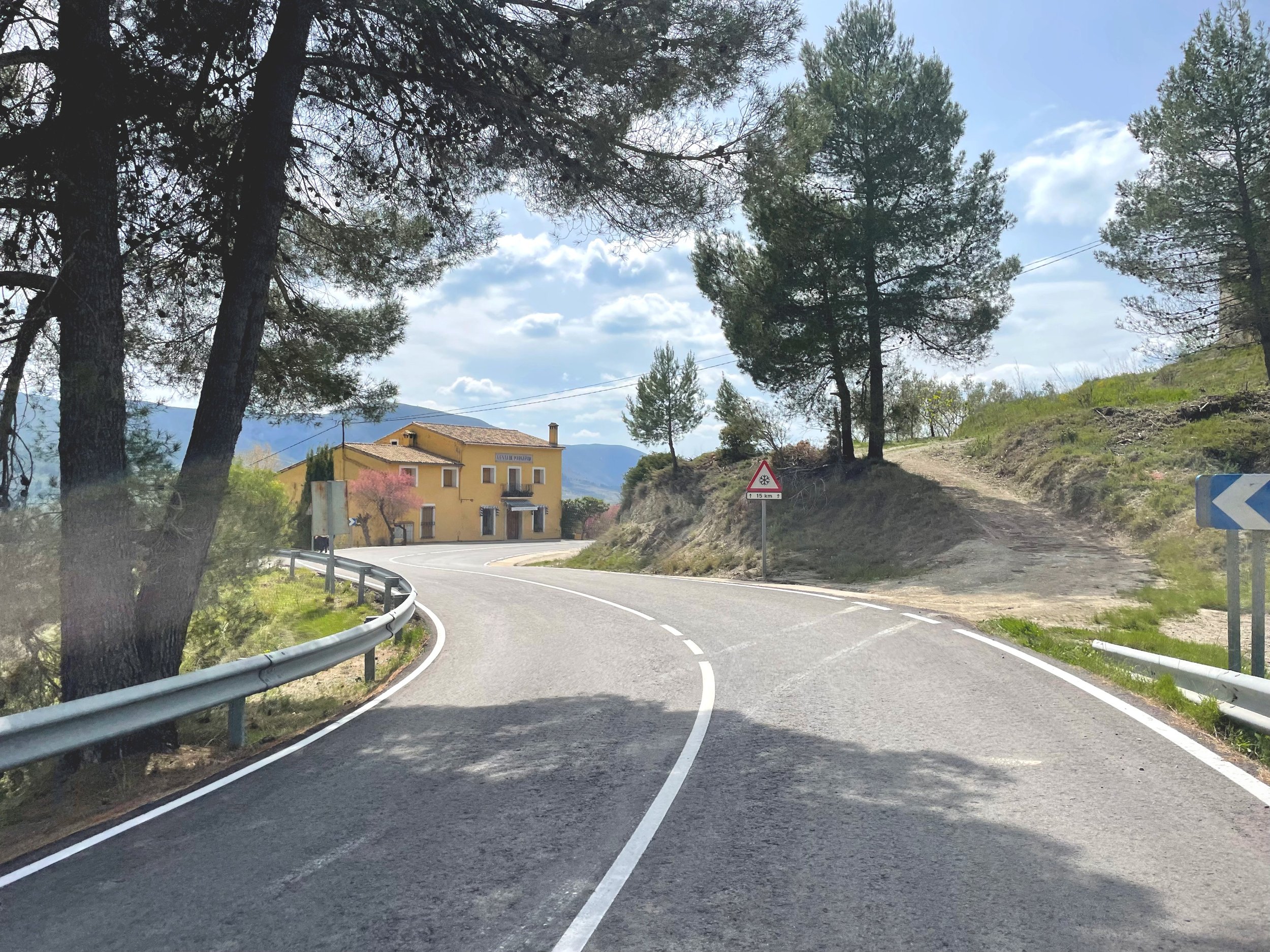Puerto De La Llacuna
Spanish riders are strong for a good reason, thanks to the endless mountains throughout the peninsula.
I thought Oregon was a mountainous state; well, it is to some extent. However, I've only seen sea to heights of +7000ft summits in Spain alone. Sure, Hurricane ridge is one of few climbs that reach a mile high from sea level. However, that ride spans over 40 miles. The nature of climbs around my family's area is completely different from that. You can ride up to heights of +4000ft in as little as 20 miles or less. Which is mind-blowing to me.
The first time I biked around Costa Blanca was quite the experience. I found myself riding up grades of +15% on the regular as if that were the usual gradients around me. And in some sense, they kinda were. Of course, you can navigate around them, but where's the fun in that?
It is safe to say that I found my calling within the mountains of Spain.
There is so much to love about the experience of riding up and down mountains and valleys.
I'm talking about microclimates, hidden pockets of untouched cultures, grand vistas, and more.
Although not as high as some of the numbers I referenced above, one such climb is the famous Puerto De La Llacuna. A climb featured as the first of six significant climbs in the 7th stage of the 2021 Vuelta a España. A true test for many local cyclists and pros as well.
The climb starts in a small farming village near the coastline of the Mediterranean Sea. Villalonga sits at the bottom of the Sierra de la Safor, a mountain range separating Valencian province from Alicante. It is also one of the gateways to the mountains, offering an escape from the heavily populated coastlines into the calm life above it all.
The world always looks better from above.
I reached out to Phil to see if he wanted to link up for a long day in the saddle in pretty much his backyard. Phil is a cycling guide that I met through a friend over Instagram, and the mountains of Costa Blanca are part of his gigantic playground.
I needed a long day in the saddle (200km), and Phil needed a leg stretcher after a long drive from Girona a few days earlier, where he had been guiding for over a week.
Villalonga was the best meeting point as it was exactly 40km away from both Xativa and Xaló.
The Route:
Setting off early in the morning to avoid the weekend traffic up and around the mountains is key whenever riding close to the mountains facing the coastline. Although drivers and motorists in Spain are very respectful towards cyclists and others alike, I still prefer a quiet road overall.
A luxury that I miss about riding in Spain.
The climb starts within the village's limits, up a twisting and winding road through some tree-covered canopies. This is one of those front-loaded climbs with steep gradients above 15%, with an average of 6% throughout the first half.
The road quickly picks up in elevation, and the village you just passed through is getting smaller with every pedal stroke up the climb.
I would pay attention to the many blind corners you'll take throughout the busy first half of the climb. The roads can get very narrow sometimes, and some drivers might be a little too spirited.
Although this is the steeper part of the climb, it is the better side when escaping the scorching Spanish sun during the summer days. Luckily in our case, it was raining a bit which was much needed to cool off a bit. There's nothing like riding through a thick luscious Mediterranean forest of pine, rosemary, and other native flora.
I've yet to find another place on earth where pine, olive, and palm trees grow feet apart, all in the wild.
The last few bends in the road before reaching the small neighborhood of La Llacuna are covered in words of encouragement painted on the pavement, a few yards before the famous La Llacuna sign.
I love climbing, I really do.
But what went through my head the first time I climbed La Llacuna was about the effort the pros have to put in so early in the stage. What a way to start the race up a cat 1 climb, followed by 10 even taller climbs.
That was a humbling experience.
As is the case most days when I ride in Spain. The riders there are on a whole other level.
The passion is there, and the people around them (none cyclists as well) show so much support and respect to those who dare climb the giant peaks of the Mediterranean coastline.
The later part of the climb levels out a bit through the neighborhood, passing by a huge burn area from a 2020 summer fire that wiped out the tree coverage over the second half, making tree coverage pretty much non-existent.
However, wide-open skies are a welcomed sight, especially when the views are as beautiful in hidden valleys above the hustle and bustle of the coastline.
With only a few steep grades left before the peak, Phil and I push through.
Well, Phil dropped me a while back, and I caught up...!
The view over the hump stopped me in my tracks.
A show of force of seismic activity took shape over millions of years during the Cretaceous period, following the Jurassic and ending with the extinction of the dinosaurs. The rising wall of limestone over La Vall de Galliner.
The hinterlands of the Mediterranean mountains.
A complex relationship between man and nature is simplified by understanding that we are a part of nature itself.
I can't emphasize enough how much I appreciate how Spain (and nations before it) paid attention to engineering with nature rather than against it.
The contouring of the road alongside the steep hills, dancing around the cliffs, designed with an artistic POV to showcase the beauty of nature around said areas.
After paying the toll of climbing the La Llacuna, we descend down La Vall de Galliner. A long downhill towards the city of Pego, passing through a handful of small villages. With the walls of the valley growing higher as we head towards the coast, so does my mood as I pedal downwards.
The countless cherry orchards on either side and the wandering light dancing on the sides of the valley.
Riding around coast-facing mountains means that you have a few options.
1. Ride up and over the mountains
2. Ride alongside the foothills
3. Ride the flats on the coastline.
Given that I still had a long way home back to Xativa and a few mountains in between, it's best to go all out. Luckily, we were at Pego, and when in Pego, you climb the Port d'Ebo. One of the area's most scenic climbs/descents with seemingly endless corners spread all along the Port.
A true local favorite.
With the morning clouds subsiding, making way for the hot Spanish sun, we reach the top of the pass and make our way to the small village of Ebo. Sitting at the heart of La Vall d'Ebo. A truly hidden gem and completely opposite from the sea-facing side of the mountain. Traffic is much better, with fewer cars and more cyclists.
One thing to not underestimate in Spain is the quality of the restaurants in small villages all around. As a matter of fact, I seek out restaurants in smaller, remote villages to find the best of the best. As was the case at Restaurante Capri, I would never decline a chance to eat Patatas Bravas, the fancier cousin of the gas station Jojos found all throughout the US.
They are equally loved in my book.
Another thing I appreciate about riding in Spain is the countless water fountains/filling spots. It is almost guaranteed that you'll find a spot to fill your bottles even in small villages, such as Ebo.
Onward up the mountain even higher and bigger, as it's almost the case throughout the Costa Blanca, heading inland is heading for the hills. Phil and I part ways at a small but critical intersection. Both of us had a few mountains to traverse before reaching home. It's always a pleasure to ride with someone who knows the land like the back of his hands, if not better!
The road back home is one that I love and know well. The reservoir westward of the Sierra de Mariola is hands down one of the hidden gems of Costa Blanca. That area is the gateway to many challenging climbs in every direction, as there is no flat way out.
By the same token, getting to the reservoir is almost all downhill, to some extent.
As mentioned earlier, the symbiotic relationship between man and nature can be seen everywhere in the rural country. one such case is the small village of Planes. On the face of it, it seems like it's floating between the sharp cliff of the reservoir.
The village is capped with the Castell de Planes with houses built on the sides of the rock (village) and all the way down to the creek that separates it from the main cliff.
Once the peak of Solana de Benicadell is in sight, you know that the last real climb of the day is just around the corner. It's one of those climbs where you can truly experience what I wrote about throughout this short post.
The roads twist and turn alongside Fincas of olive and oranges, with a handful of beautiful views of the Ermita del Santissim Crist dels Afligits aligning with the towering peak behind it.
The views around the Pantano de Planes are not to be missed. Even with sore legs, and an empty stomach, by the time I got to the last real climb of the day, all of the noise went quiet, and all I could think about was what was in front of me.
A view that could've easily put a smile on Bob Ross's face.
I hope.
And with the sun heading for the horizon, I marched on to my childhood's beloved and tranquil town, Xativa.




















